Our theme is a wall. A wall that is neither some ordinary physical structure at a specific site, nor a symbolic wall. It takes a material form in sites around the globe while transcending locations and leapfrogging whole continents as if in a strange quest to globalise itself, to infect our supposedly unifying world with a sinister, impenetrable division – a wall that is so familiar and yet so inconvenient that most gaze away from it. The seeds of our wall were sown in the Balkans, in Yugoslavia and in Greece under Nazi occupation. The harvest began in the streets of our hometown, Athens, in December 1944, yielding a civil war that, although atrocious and globally significant, went virtually unnoticed. But
Topics:
Yanis Varoufakis considers the following as important: Architectural Review, Arts, culture, DiEM25, English, Essays, Political, The Global Minotaur: A theory of the Global Crisis, Vital Space
This could be interesting, too:
Chris Blattman writes Top 10 family board games we discovered during the pandemic
Chris Blattman writes Top 10 family board games we discovered during the pandemic
Jeff Mosenkis (IPA) writes IPA’s weekly links
Yanis Varoufakis writes Jamie Galbraith on DiEM-TV’s ‘Another Now’ discussing the “criminal incapacity of the elites”
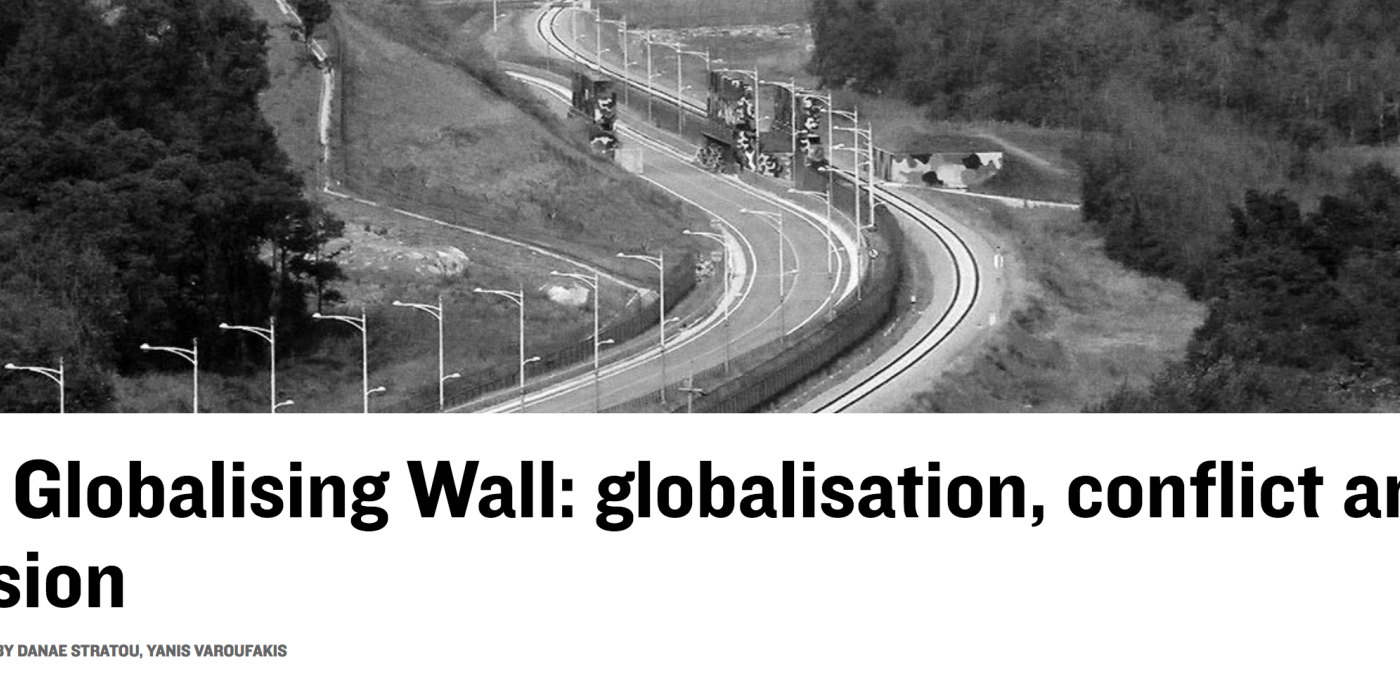
Our theme is a wall. A wall that is neither some ordinary physical structure at a specific site, nor a symbolic wall. It takes a material form in sites around the globe while transcending locations and leapfrogging whole continents as if in a strange quest to globalise itself, to infect our supposedly unifying world with a sinister, impenetrable division – a wall that is so familiar and yet so inconvenient that most gaze away from it.
The seeds of our wall were sown in the Balkans, in Yugoslavia and in Greece under Nazi occupation. The harvest began in the streets of our hometown, Athens, in December 1944, yielding a civil war that, although atrocious and globally significant, went virtually unnoticed. But the world began to pay attention when, from the streets of Athens in December 1944, it moved to Berlin, which it partitioned in the following June. The world noticed when it produced two Koreas in that August and leapt to the mountain ranges of Kashmir exactly two years later, as the new fledgling nations of the subcontinent clashed instead of celebrating independence. The world sat up when it flared up in 1948 in the guise of ethnic cleansing and in the midst of all-out war in Palestine and when it made its mark in the streets of Nicosia with a green line – which had been drawn innocuously by a British general in 1956 – before returning in the form of barricades in 1963, two years after the similar soft division in Berlin was transformed (in four short days) into the wall’s most famed incarnation.
When the Troubles erupted in Belfast, and Sunday 30 January 1972 was indelibly bloodied by the British Army, it was there to embellish the pre-existing discontent with ‘peace walls’. Two years later, the barricades along Nicosia’s Green Line, as if in a bid not to be outdone by Berlin or Belfast, also grew into a fully fledged wall.

The Berlin Wall divided the city from 1961 until 1989. Image courtesy of CMSgt Don Sutherland / US DOD
Then, in 1989, while the Berlin Wall was falling, and the world was turning, supposedly, into our global playground, something remarkable happened. Instead of disappearing, these walls grew taller, more impenetrable, longer, stronger, uglier. They invaded disintegrating Yugoslavia, stood tall in the midst of hitherto unified communities in Africa’s Horn (where they claimed grey zones from the rugged tablelands between Ethiopia and Eritrea), turned more insidious and fiendishly complex in Palestine, along the US-Mexico border, in the streets of Baghdad, in Georgia, in Ukraine, in our own cities, their shopping malls and gated pseudo-communities.
We were hit by a great paradox: the more globalisation was meant to give reasons for dismantling the dividing lines, the less powerful the forces working to dismantle them were proving. Deepening divisions, patrolled by increasingly merciless guards, and convoluted architectural techniques, roads, tunnels and fortifications, appeared to us the homage that globalisation was paying to organised misanthropy.
‘We were hit by a great paradox: the more globalisation was meant to give reasons for dismantling the dividing lines, the less powerful the forces working to dismantle them were proving’
In this era of globalised financialisation, divisions were not what they used to be. In times past they simply fended off the enemy, and lightly imprinted the empires’ footprint on the land. Before the ‘discovery’ of the autonomous individual, the ancient polis dreamt of demolishing its walls or, at least, of never having to keep its gates closed. When a son of an ancient Greek city won an Olympics event, the elders ordered the demolition of part of the city walls. Only at times of crisis or degeneracy were the gates ordered shut. Unlike today in North Korea or the southern states of the US, open gates were, then, a symbol of power. Hadrian and the Chinese emperors built great walls, but never with the intention of freezing human movement. They were porous walls, mere symbols of their empires’ self-imposed limits, and a form of early warning system.

Hadrian’s Wall, England, begun AD 122, marked the northern limit of the Roman Empire. Photograph by Steven Fruitsmaak
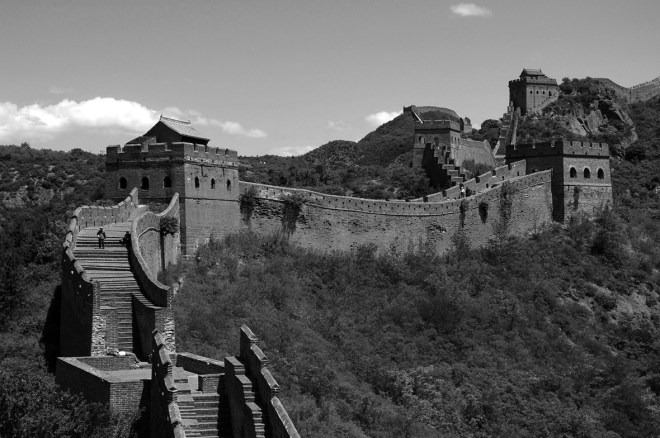
China’s Great Wall, built over centuries, protected against invasion. Photograph by Jakub Hałun
Fences took on a new role and character at the time European feudalism was running out of steam. Under the strain of the commodification made possible by the new trade routes that linked Southampton with Calcutta, Macao, Japan and the ever-increasing number of colonial outposts strewn all over the globe, the English commons were cut up, fenced off, privatised. So the Enclosures ‘liberated’ the peasants from access to common land and the free labourer was born.
For the first time in history, they became free to choose and, equally, free to lose. Free to rove unimpeded, free to sell their labour, time, body and spirit to whomever, and equally free to starve, enter into desperate contracts with strangers, become a sad part of some productive machine owned by a faceless shareholder. So the age of reason and liberty was ushered in, hot on the trails of the globalisation drive that, on the one hand, fenced the peasants out of their commons at home and, on the other, fenced the slaves in ships to transport them to fenced-off land in the Caribbean and elsewhere, where they were put to work, producing the great surpluses that funded the Industrial Revolution.
From this wealth emerged the castles that Englishmen called home and for whom the fence separating their property from the next one became symbolic of freedom, neighbourliness and subservience under their sovereign. The accumulation of this wealth was the predecessor of the fenced sovereign nation, the gated neighbourhood and the notion of home as one’s castle. It followed the idea that the enemy of autonomy is the ‘other’, either as an individual or, even worse, as a collective, a State, the Inland Revenue …
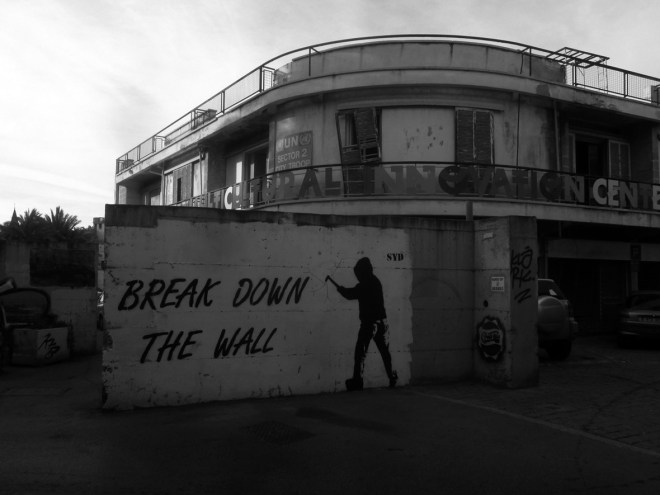
The Green Line in Nicosia became impassable after the July 1974 Turkish invasion of Cyprus. Photograph by Owen Hatherley
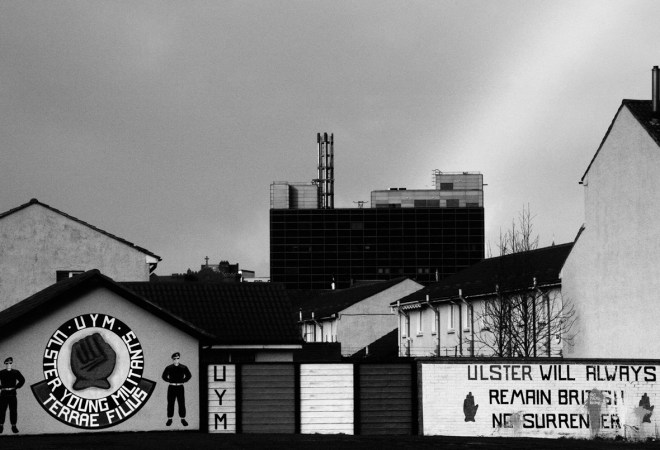
The ‘peace walls’ in Belfast separated Nationalist Catholics from Unionist Protestants during the Troubles. Photograph by Danae Stratou
Once the American Revolution had rid the ex-colonies of the transatlantic sovereign as surplus to the requirements of the New World’s drive to accumulate, the US Constitution revelled in the light of reason and liberty while erecting fences to cast in stone the rights of man, defined in terms of freedom from interference; fences that would keep the riff-raff out and, of course, keep the state and the executive at bay; constitutional fences marking the autonomous realm of the liberal bourgeois individual. Border fences, in this manner, became synonymous with modernity in Europe, while in Africa, the Caribbean, parts of the American West, and of course Australia, the fence remained for decades the handmaiden of slavery, expropriation and genocide.
Meanwhile, at the level of theory, for at least 300 years now, reason is defined as the absence of unreason; as if a mighty fence separates the two, with reason maintaining a unique narrative to offer on unreason – courtesy of, on the one hand, economics, and, on the other, psychiatry. In the same manner, freedom is defined almost instinctively as the instrument that demarcates the self and pushes back the interfering others; whether they are foreign armies, migrant workers, one’s own employees, the homeless, even one’s nearest and dearest.
The very notion of the individual that emerged out of Anglo-Saxon capitalism hinges on the idea of ‘well-defined’ spaces within the ‘walls’ that exclude. So our newfangled concept of liberty and progress is contingent on the prior colonisation of ‘alien’ others, while our splendid cosmopolitanism is bought at the price of parochial divides that mindlessly cut the Earth’s face, giving shape to a world map divided, supposedly neatly, into nation-states.

Mitrovica in Kosovo is divided in two with Serbs living in the north, and Albanians in the south, separated by the Ibar river. Photograph by Danae Stratou

Peru’s 3-metre high ‘Wall of Shame’ in Lima divides the wealthy neighbourhood of San Juan de Miraflores from the poor region of Surco. Image courtesy of Anadolu Agency / Getty Images
Modernity, in short, spawned fences, walls and fortifications fit for exciting new roles. They liberated the individual from the tyranny of the ‘other’ and replaced love for one’s neighbour. They gave rise to the proletariat, so hugely expanding the productivity of labour, pacified the colonised, and marked the nation-state’s territory. Modernity’s fence imprisoned the alien, exterminated inconvenient peoples and institutionalised the weird. The fence helped destroy the silly old world and gave a hand to the construction of modern empires that the Romans could never have imagined.
One diary entry from our visit in March 2006 to Juarez, Mexico, while ‘studying’ perhaps the most sinister segment of the US-Mexico border, stands out:
‘It is not just that the walls are getting stronger, rather than more brittle. It is also that they are globalising. The reason seems to be because the importance of deep divisions for stabilising a grossly unstable world order is growing by the day. The raison d’être is the same: it affects different walls in similar ways; they start resembling each other. Both in terms of the social forces that huddle in their shadow but also physically. Aesthetically. A Mitrovica Serb would feel more at home in Nicosia than in Belgrade. An Eritrean residing in Tsorona will feel a sense of familiarity, despite the intense cold, near the Line of Control in alpine Kashmir than she would in Asmara. An Ulster unionist will have no trouble coming to grips with the reality of the ghost city of Famagusta, in Cyprus, whereas he may well feel a stranger in London. A Palestinian from Qalqilia will discover strange bonds with a resident of Juarez, bonds that she may not feel in Cairo. The mere fact that Israeli engineering teams have been employed by the US government to help transplant Sharon’s Wall to California, New Mexico, Arizona and Texas speaks volumes.’
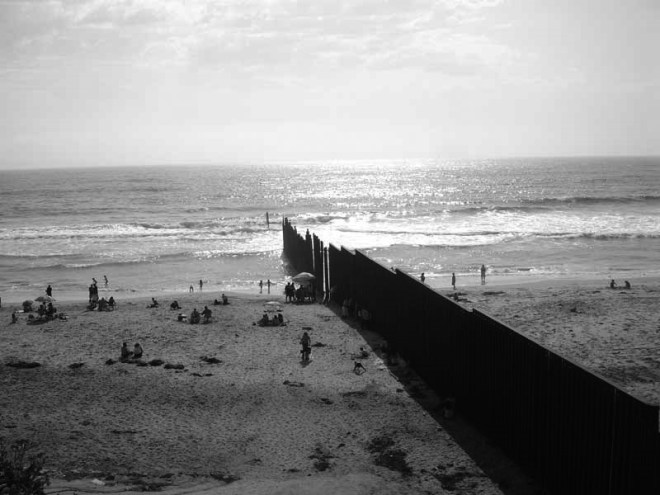
Border Field State Park in San Diego forms a beach border between Tijuana, Mexico, and the US. Photograph by James Reyes

The Western Sahara Wall in Morocco separates Moroccan-occupied and controlled areas from those controlled by the Polisario. Running inside the border between Morocco and Mauritania, it extends as far north as Algeria. Image courtesy of Patrick Hertzog / AFP / Getty Images
Since our travels along the Globalising Wall, globalisation has had its comeuppance. The perverse flow of increasingly unbalanced money and goods that underpinned the myth of a Global Village had produced a wave of unsustainable financial trickery.
The steady stream of European and Asian profits rushing into Wall Street since the 1980s had, by the 2000s, turned into a tsunami of synthetic debts on a whirlpool of financial flows. Bankers were building Midas-like fortunes by inflating oversized bubbles of exotic forms of private debt which, at some point, had surreptitiously acquired the properties of private money. By autumn 2008 these bubbles had burst, causing our generation’s 1929 moment. Together with the financial bubbles, something else broke: the recycling mechanism that held globalisation together –US trade deficits generating global demand for the net exports of Europe, Japan, later China, South-East Asia and so on which, in turn, were paid for by the flood of profits rushing into Wall Street to complete the recycling loop. In 2008, despite energetic money-printing by central banks (and the Chinese authorities’ breathtaking credit and investment spree), this loop broke down. It was only a matter of time before the myth of globalisation would begin to unravel.
‘With globalisation in retreat, militant parochialism filled the space, bolstering the Globalising Wall, which is now running amok, spreading further afield’
American deficits, even after they returned to their pre-2007 levels, could no longer stabilise globalisation. The reason? Socialist largesse for the few, and ruthless market forces for the many, damaged aggregate demand, repressed the entrepreneurs’ sales expectations, restricted investment in good jobs, diminished earnings for the many and, surprise surprise, confirmed the entrepreneurs’ pessimism that underpinned low investment and low demand. Adding more liquidity to that mix made not a scintilla of a difference as the problem was not a dearth of liquidity but the dearth of demand. Abysmal inequality was merely the symptom.
Wall Street, Walmart and walled citizens – those had been globalisation’s symbolic foundations before 2008. Today, all three have become a drag on globalisation. Banks are failing to maintain the capital movements that globalisation used to rely on, as total financial movements are less than a quarter of what they were in early 2007. Walmart, whose ideology of cheapness symbolised the devaluation of global labour and the gutting of traditional local businesses, is itself squeezed by the Amazon model, whose ultimate effect is a further shrinking of overall spending. Meanwhile, the 3D printer, CAD and AI robots promise to de-globalise – and re-localise – production, denying, in the process, countries like the Philippines and Nigeria the advantage that young populations used to bestow on them during the years of globalisation’s rude health.
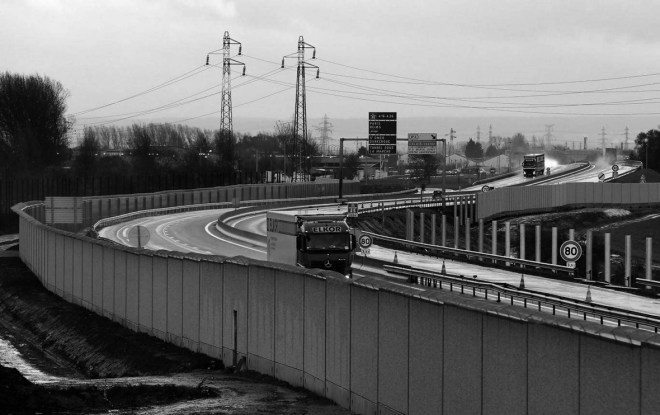
Tall walls have been built on motorways in Calais to prevent migrants in search of a better existence from accessing lorries bound for England. Image courtesy of Gareth Fuller / PA Archive / PA Images
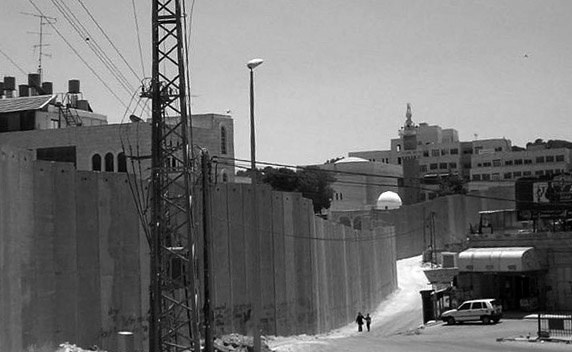
In clear violation of international law, a huge wall was constructed straight through the Palestinian town of Abu Dis in the West Bank by Israel. Image courtesy of Zero
With globalisation in retreat, militant parochialism filled the space, bolstering the Globalising Wall, which is now running amok, spreading further afield. The victims of globalisation, good people who believed the lie that it was a tide lifting all boats, are now turning for a false sense of security (or, in some cases, a safe place in which to be angry) to walls, to Brexit, to the bosom of a powerless nation state. So new walls are rising between countries that had, until recently, proudly given up their border posts; for example, Germany, Italy and France. The Mediterranean is being exploited as a watery fence-cum-grave by European rulers eagerly striking deals with Libyan traffickers and the Turkish president to allow them to violate the internationally guaranteed rights of refugees. On the other side of the Atlantic, a president was elected, pledging to build a better, a more vicious wall anywhere he could. The longer this list of horrors grows, the greater our moral and political duty to confront this failing globalisation with a renewed, ambitious internationalism. Taking down its hideous, Globalising Wall seems like a good place to start.
These photographs include two by Danae Stratou from the installation CUT – 7 dividing lines (2007), which was part of The Globalising Wall, a project begun in 2005 with Yanis Varoufakis.
Lead image: The Donghae Bukbu Line, 1953, in the Korean Demilitarized Zone. Image courtesy of Kussy.
This piece is featured in the AR’s June 2018 issue on Power and Justice – click here to purchase a copy and here for the AR’s website
